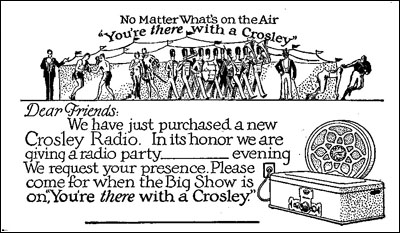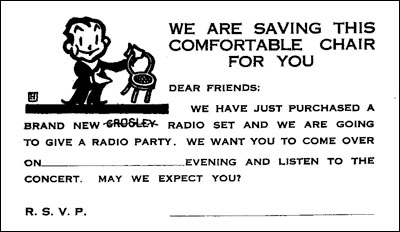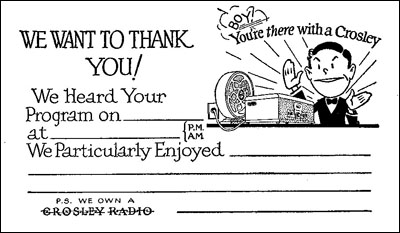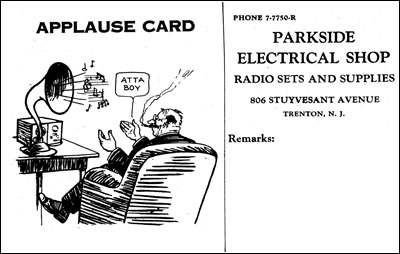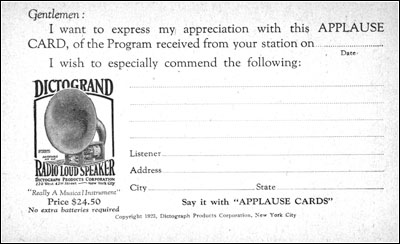Of Old Radios And Related Items--Published Monthly
Early Radio Applause Cards
BY MICHAEL A. BANKS
Web Edition
Listener appreciation of radio broadcasts in the form of "applause cards" had to be of great value to early radio's programmers, as well as to manufacturers and dealers who were eager to take advantage of this way of seizing public attention.
Michael Bank's article has been augmented with two cards from your editor's collection. Donald Ignatius also had sent in cards earlier, suggesting an article on Crosley applause cards. Here at last is a combined finished product. (Editor)
In the early days of commercial radio broadcasting, listener reports were a valuable source of information on listener demographics. Broadcasters encouraged listeners to write in, and sometimes offered prizes. But radio audiences in the 1920s didn't require much prompting; most radio fans were so enthusiastic that they were glad to share their listening experiences with anyone.
The simplest way to send a listener report was with a penny postcard, and this quickly became the preferred medium for listener reports. The typical listener report consisted of the date and time, along with the name of the show received, and a brief comment or two. The cards became known as "applause cards," because they were used to convey appreciation of a station or specific show.
A few enthusiastic radio fans had special postcards printed. These carried a note of appreciation and blank spaces for time, date, and station/program information. The standard card carried a message along the lines of
"Here in _______, ____, we greatly enjoyed your program _______, at ______ AM/PM on __________, 19__."
Promotion
A few enterprising individuals got into the business of printing applause cards for sale; however, the fledgling industry died almost before it got off the ground. Competition was too keen from the radio and radio equipment manufacturers who seized on the idea of applause cards as a means of promotion.
Companies such as Crosley Radio Corporation and Zenith Radio packed several applause cards with each new set. As seen in the accompanying illustrations, manufacturer applause cards noted the brand of set used.
The Crosley Radio Corporation took things a step farther and included several invitation cards for new Crosley owners to use to invite their friends over for a radio party (a popular urban event in the early 1920s). As can be seen, these cards also plugged Crosley sets, hopefully encouraging the friends of the new radio owners to buy the same. A 1924 marketing survey indicated that current radio owners were the biggest influence in new radio purchases.
As shown here, applause cards were also distributed by dealers, such as the Parkside Electrical Shop and the Dictograph Company, which made radio speakers. The messages encouraged the public to come in and load up more cards for free.
Applause cards were sometimes used to advertise nonradio goods, usually by companies that sponsored radio programs. Among many others, the Waterman Ink Pen Company and Happiness Candy Stores distributed free applause cards through its retailers. Radio stations often sent out preprinted applause cards for their listeners to use as well.
Radio applause cards were a relatively short-lived phenomenon. They came into existence when radio first became popular in 1922, and faded around 1926. By that time, radio was no longer the novelty it once was, and stations began relying on professional surveys, advertiser results, and other means of gauging the extent of their audiences.
Applause cards turn up now and then on eBay. When they do, they usually sell in the $5 to $8 range, used or unused. Used applause cards are sometimes of greater value if they mention a specific, well-known performer or were sent to a popular radio station like WOR, WGN, WLW, or KEAF. Applause cards advertising nonradio merchandise are the rarest.
(Michael A. Banks, P.O. Box 175, Oxford, OH 45056, E-mail: mynewbook@aol.com)
A native of the Cincinnati area, Michael Banks is co-author of the book "Crosley: Two Brothers and a Business Empire That Transformed the Nation." (Clerisy Press, 2006) He also can be reached through http:/www.michaelabanks.com.
| [Free Sample] [Books, etc., For Sale] [Subscribe to A.R.C./Renew] [Classified Ads] [Auction Prices] [Event Calendar] [Links] [Home] [Issue Archives] [Book Reviews] [Subscription Information] [A.R.C. FAQ] URL = http://www.antiqueradio.com/Mar07_Banks_ApplauseCards.html Copyright © 1996-2007 by John V. Terrey - For personal use only. Last revised: February 28, 2007. For Customer Assistance please contact ARC@antiqueradio.com or call (866) 371-0512 toll free Pages designed/maintained by Wayward Fluffy Publications
Antique Radio Classified |

